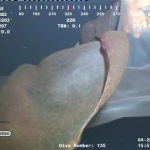I study deep-corals (gorgonians mostly) but I am fascinated by all things cnidarian (sea anemones, hydroids, jellyfish, corals). These are suspension feeders that filter food from the water column, so I am also inevitably drawn to dabblings in physical oceanography, and I will try to post on these whenever I can. For now, though, I think I’ll use my first post at the new Deep-Sea News to spill the beans on some old trickery.
One thing you should know about DSN is that Craig keeps real strict rules on his definition of the deep-sea, so I work to find a way around this when something interesting pops up in shallow waters. For instance, Craig will use his (very awesome) “25 Things You Should Know” series to tell you 200m is a minimum depth cutoff for the deep-sea. However, many sea creatures (like squid) ignore this boundary, so I try to navigate through this barrier with “depth certified” asides that fly under Craig’s 200m radar. See the “extended entry” below. You’ll see more of this tomfoolery in future posts about sea turtles, whale sharks, and waterspouts.
Jellyfish are one of the most unexpected and delightful encounters in deep-sea surveys. They cast shadows on the seafloor big enough to frighten you, and fly at the video cameras to fill the frame in spectacular displays.
Jellyfish are attracted to light through primitive eyes called rhopalium, but the most deadly jellyfish, the cubozoans, have sophisticated visual systems. New research on cubomedusans investigates these elaborate eyes that can see a burning match meters away, navigate around dark objects, and actually see people.
This month’s Journal of Morphology reports visual processing and integration in a diffuse system spread throughout the rhopalium of the toxic box jellyfish Tripedalia cystophora (Skogh et al. 2006). These and other results (Nilsson et al 2005, Parekfelt et al 2005) show that a major part of the rhopalial nervous system is bilaterally symmetrical. One website reports at least 8 human deaths from box jellies. So beware, my friends, if the carnivorous sponges don’t get you, the jellyfish will.

References
Nilsson DE, M Coates, L Gislen, C Skogh, A Garm. 2005. Advanced optics in the jellyfish eye. Nature 435:201-205.
Parkelfelt L, DE Nilsson, P Ekstrom. 2005. A bilaterally symmetric nervous system in the rhopalia of the radially symmetric cubomedusa. J Comp Neurol 492:251-262.
Skogh C, A Garm, DE Nilsson, and P Ekstrom. 2006. Bilaterally symmetrical rhopalial nervous system of the box jellyfish Tripedalia cystophora. J Morph. 267: -13911405






Andrew Parker seems to argue that the box jellyfish’s eye can be ruled out of the evolutionary history because there’s not enough brain there to utilise it, although he admits that this is a question-begger (so why would a creature that couldn’t profit by image formation maintain a serious eye?).
If those results are what I think they are, that needs some serious revision, right?
“visual processing and integration”
Peter, do they give an guess about what type of processing and integration are occuring? For example, if some predator was overhead, in the way of the sunlight, would the jelly be able to determine that this is a threat. Would they be able to use size perhaps (a 10m whale vs .5 m fish) as a clue?
But, do they have clocks? And if so, is that visual system involved in photic entrainment of the clock?
“New research on cubomedusans investigates these elaborate eyes that can see a burning match meters away, navigate around dark objects, and actually see people.”
Hmmm, I guess the next time I’m down below 200m I won’t be lighting any matches…
In case you’re wondering I’m an ex commercial deep sea diver certified 500ft Subsea Oil. These days I restrict my diving to snorkling on coral reefs from my kayak off Hollywood beach Florida where I now live.
Anyway I guess the surface dwelling Portugues Men of War that occasionally sting me probably don’t qualify for a mention on a site that’s called Deep-Sea News.
Cheers!
Hi Guys. Thanks for these comments. Bear with me as I try and answer questions. I have only a general knowledge of these jeellyfish eyes. The eyes are fairly well established in the literature, but Skogh et al state that “the question remains as to whether or not there is a rhopalial ganglion”. They note strong evidence for a pacemaker signal leaving each of the rhopalia, and believe this is modulated by input from the eyes. Therefore, the type of processing and integration is photic stimulation that directs the box jelly’s steering and turning through contractions of the bell.
By the way, Chris and Fernando, I hear Discovery Channel or some other is running a documentary on box jellyfish that suggests they try to “avoid” stinging people. Sound like a tough sell, though!